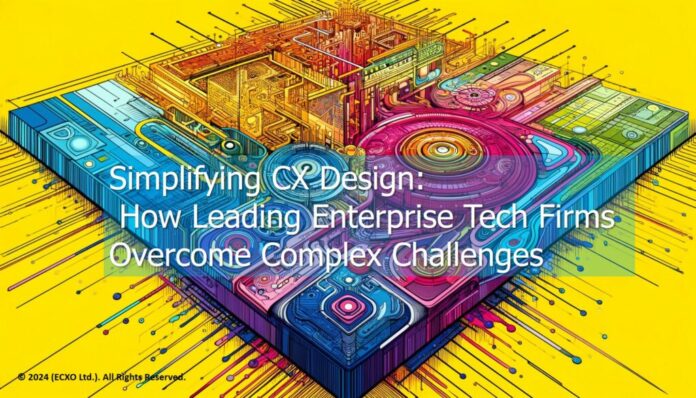By Ricardo Saltz Gulko
This article is published through a partnership with the European CX Organisation (ECXO). View the original or learn more about the ECXO.
Seamless customer experiences and clear interfaces are two key elements leveraged by successful tech enterprise to generate adoption, with design being the key to overcoming solution complexity. Intuitive, clear designs make it easier to generate adoption, decrease customer success costs, and help customers adopt the solutions easily with the right onboarding. The challenge is how.
The answers is Yes. And also, no. Let me explain:
The success of enterprise software giants like Samsung Solutions, SAP, Oracle, and Salesforce despite the complexity of their interfaces can be attributed to a combination of factors. To understand them, we must consider the unique and specific context of enterprise software, which differs significantly from consumer software in terms of user expectations, purchase processes, and implementation scale.
The answer to success: Overcoming decision fatigue

In many cases, what limits adoption is our ability to decide (or lack thereof). Imagine having to choose between 3 features to solve a problem, versus being offered 15 different features for it. Our distinct preference for the former is due to our limited decision-making capacity per day as humans, a notion touching on psychological and cognitive science theories.
In cognitive psychology, there’s a concept known as “decision fatigue,” suggesting that the quality of our decisions deteriorates after making a long series of them. The reason is that decision-making involves cognitive processes that can be taxed over time, leading to a reduced ability to make sound choices. When we make decisions, we use mental models that are essentially internal representations of our understanding of reality. These models are formed through personal experience, education, and culture, which means what one person perceives as complex might be perceived as very simple by another.
So, how do leading tech corporations bypass our decision fatigue as users despite the complexity of their solutions? Let’s divide what they do into several key areas.
- Comprehensive Solutions
- Enterprise-Level Needs: These companies offer comprehensive solutions that address various business processes, including CRM, ERP, and SCM. Enterprises often require such complex systems to manage their operations effectively, and these platforms provide an all-in-one solution.
- Customization and Flexibility: Despite their complexity, these systems are highly customizable, allowing businesses to tailor the software to their specific needs and their users’ needs. This flexibility is crucial for large organizations with unique processes and requirements.
- Ecosystem and Integration
Strong Ecosystem: SAP, Oracle, and Salesforce have built extensive ecosystems around their software, including partners, developers, and consultants. These ecosystems support customers from implementation to ongoing maintenance and customization, easing the challenges associated with complex systems and the experience challenges.
- Integration Capabilities: These platforms offer robust integration capabilities with other business systems, which is a critical factor for enterprises that rely on multiple software solutions. The ability to seamlessly share data across systems can justify the complexity and cost of implementation.
- Market Presence and Brand Reputation
- Established Market Presence: Having been in the market for decades, these companies have established a strong reputation and reliability. Enterprises are often willing to navigate complexity for the sake of partnering with a vendor that has a proven track record.
- Trust and Security: Large organizations prioritize security and compliance, areas where SAP, Oracle, and Salesforce have demonstrated competence. The trust in their ability to protect sensitive information can outweigh complexity concerns.
- Strategic Sales, Customer Success and Support
- Enterprise Sales Strategies: The sales processes for these companies are highly sophisticated, involving direct engagement with several decision-makers, demonstrating potential ROI, and providing assurances about support and customization capabilities. Often many stake holders and decision makers are involved specially in B2B
- Enterprise Sales Strategies: The sales processes for these companies are highly sophisticated, involving direct engagement with several decision-makers, demonstrating potential ROI, and providing assurances about support and customization capabilities. Often many stake holders and decision makers are involved specially in B2B.
- Comprehensive Support, and Training: All these complex solution providers focus significantly on onboarding and ensuring their new and existing customers are successfully utilizing their solutions. They offer extensive support and training services to help organizations adopt and use their systems effectively. This support can significantly mitigate the adoption barrier posed by complexity.
- Network Effects and Lock-in
- Vendor Lock-in: Traditionally, once an enterprise had invested in and customized a complex system, the switching costs associated with legacy technologies were often prohibitive. Today, even with cloud solutions, there can still be significant costs and penalties embedded in contracts, making switching challenging. This lock-in effect can make it difficult for businesses to move to a competitor, ensuring a steady stream of revenue for the provider.However, today to move for a competitor is easier then before. It’s important to note that with the rise of cloud-based solutions, disconnecting in case of dissatisfaction is becoming easier.
- Network Effects: As more businesses use these platforms, third-party developers are more likely to build integrations and applications for them, increasing their value and creating a network effect that benefits all users.

Conclusion: In Some Cases, Complexity Can Be Made Worthwhile
While complexity can be a major barrier to software adoption, companies like SAP, Oracle, and Salesforce have succeeded by offering comprehensive, customizable solutions that meet the unique needs of large enterprises. Their ability to provide strong customer success team support, integration capabilities, and security, coupled with their established market presence and ecosystem, helps overcome the challenges associated with their complex systems. Imagine the potential savings in customer success investments if companies were to prioritize proper design, thereby naturally fostering greater adoption and loyalty.
Wait. What If I Have a Small or Medium Business?
Medium and small players entering markets dominated by giants like SAP, Oracle, and Salesforce face significant challenges, but they also have unique opportunities to differentiate themselves and capture market share. While they can’t implement identical strategies to those utilized by the bigger players, there’s plenty they can do to ensure adoption of their solutions.
As we consider the evolving landscape of technology, one final question remains for our contemplation: Will AI significantly enhance software design and human perception in the future? I look forward to exploring your thoughts and perspectives on this intriguing topic.
To learn about strategies that smaller competitors can adopt to effectively penetrate the market and attract customers, read Part II coming soon.

